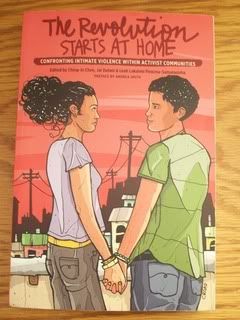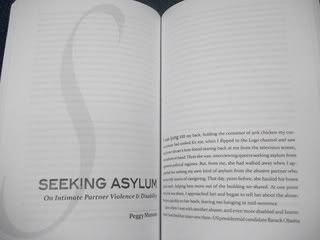![]()
TRIGGER WARNING for descriptions of abuse of people with disabilities. Hell, the whole darn book is a trigger warning for abuse, rape and other triggering stuff.
Description: Photo shows the cover of a book. Two people of color are drawn, holding hands and looking at each other on a balcony. The person on the right has short curly hair and brown skin and is wearing a green t-shirt and jeans. The person on the left has long curly hair caught up in a hair tie at the back of the head and also has brown skin. The person is wearing a light purple t-shirt and yellow belt and brown pants. Both people are wearing bracelets. In the distance are electricity poles and houses. The background colour is a warm orangey red. The text says: “The Revolution Starts At Home: Confronting Intimate Partner Violence within Activist Communities. Edited by Ching-In Chen, Jai Dulani and Leah Lakshmi Piepzna- Smarasinha. Preface by Andrea Smith.”
Attempts to deal with intimate partner violence for able-bodied folk are pretty woefully inadequate. However, as Peggy Munson testifies during this searing chapter in The Revolution Starts at Home: Confronting Intimate Partner Violence Within Activist Communities, attempts to deal with disabled persons who are surviving intimate partner violence are in many ways non-existent and at best are sadly lacking in many areas.
Description: Photo shows two pages of a book. On the left hand side is the chapter’s name: Seeking Asylum (in capital letters and black font): On Intimate Partner Violence and Disability. (in what resembles italics and black font.) The Author’s name is Peggy Munson. There is a large grey-coloured, stylized capital ‘S’ that goes almost from the top to the bottom of the page, passing through the word ‘seeking’. On the right hand side of the book, the essay begins on the lower third of the page.
Ms. Munson’s essay weaves her arguments into her personal narrative of her experience with abusers and the broken systems that kept her tied to them. She then buttresses her line of reasoning with copious examples, all testament to the fact that the social justice community is woefully unable to offer much help in terms of providing care to survivors, enabling them to report and escape abuse or holding abusers accountable. Some of the points that she makes include:
1. Societal ableism, which too many social justice seekers have not properly interrogated; makes abuse of people with disabilities much worse because abusers are often the only people who make the effort to provide proper life-sustaining care to people with disabilities, in order to exploit and abuse them:
To understand how disability functions in Intimate Partner Violence, one has to shelve denial about how deeply inaccessible US culture can be to people with some disabilities. The Americans with Disabilities Act … polarizes disabilities into the “reasonable” and “unreasonable” by using the term “reasonable accommodation” to denote just how far requisite allowances must go. … Some disabilities cross a line by becoming — by cultural standards– too unwieldly to accomodate, resulting in a warped and deadly triage of the “reasonably” disabled who get some human rights, and the “unreasonably disabled” who don’t.
…
People from social service agencies frequently tell me that my disability would place unreasonable demands on everyone else.
…
In a culture that shuns and penalizes human vulnerability and provides at best an inadequate and spotty caregiving net, people with disabilities often rely on their abusers for food, bathing, toileting, transportation and other survival needs. Many caregivers–not just partners–have intimate access to the lives of people with disabilities. But leaving an abusive relationship can be imminently life threatening because victims might lose sustaining care, and replacing this can be next to impossible unless their are non-abusive family members or friends willing to provide it. If IPV organizations don’t understand this pressing need for transitional (or long-term) hands on care, a disabled person will often not be able to leave.
In short, we have managed to set up a society in which the more you need help, the less human rights you are entitled to. The closer to able-bodied you are, the easier it is to navigate the world of the ablebodied in order to get care, to avoid abuse and report abuse. As you become more vulnerable however, you become less able to access proper care, negotiate abuse-reporting channels that are exhausting for able-bodied people, nevermind people with disabilities; and have to contend with ableist assumptions about what abuse is and how you should be able to deal with it; thus leaving you at the mercy of abusers.
And this cultural indifference and callousness plays out in situations like the general inaccessibility of the legal system; here represented by Ms. Munson’s experience of trying to file a restraining order against one of her many abusers, only to find herself unable to because the courthouse required that she be there in person to go through the process, even though she cannot leave her house because of extreme chemical sensitivity. In addition, society is generally reluctant to incorporate universal design when we build our buildings; with the result that domestic violence shelters are unable to properly accommodate people with disabilities, who are among the most vulnerable of abuse victims:
Many IPV organizations are in fact performing oppressive acts of neglect and exclusion that mimic those of abusers, by denying access (not providing materials in braille, not installing wheelchair ramps, not enforcing strict fragrance free polices) … using a tired social justice argument that its too hard, too expensive, or too embarrassing to ask others for accommodation requirements, so that they avoid accountability for their marginalization of people with disabilities.
Then there is the lack of accessible communication methods with IPV specialists depending on the disability, IPV organizations not knowing the laws that would protect their clients, (like the fact that the state requires that abuse of people with disabilities be reported to the relevant authorities), and appointed advocates who have not been educated as to the different ways in which abuse can manifest among people with disabilities, nor about the different methods of communication that need to be put in place to accommodate them.
By and large, it is not Stockholm syndrome that holds a disabled person to an abusive caregiver, but material and often elaborate acts of acts deprivation and torture. When some has a disability, these acts are easy to inflict (and obscure from the point of view of others): they may just be a matter of hiding someone’s painkillers, or sabotaging his TTY (text telephone), or — most insidously — becoming and indispensable aid so that he cannot function without the provided care. Disabled individuals cannot just get up and go… Whereas a safety plan for an ablebodied person may involve words like run, walk, call or drive, these action verbs may not be possible for a quadriplegic, a heart failure patient, someone with a brain stem injury, or someone with a cognitive impairment. It is naive to assume that a disabled person can be ushered into a world of safety simply be leaving her abuser, when the world at large is full of physical, emotional, economic and cultural barriers.”
(As a related aside, a commenter on a Racialicious article named Empower and Educate has similar remarks re:deaf persons and domestic violence here)
2. The idea that taking care of people with disabilities is not a communal priority in a society that equally values all of inhabitants, but a rare and heroic action, worthy of extreme pats on the back by an ableist society and gratefulness on the part of the people with disabilities who are lucky enough to receive this help. Society expects that any caregiving should be primarily the family’s responsibility. Ms. Munson’s family refuse to step up to the plate, so Ms. Munson was forced to rely on partners willing to embark on a romantic relationship with her in order to get sustained care, because caregivers who were paid to take care of her were hard to keep, did not learn about her illness in detail and did not have enough hours. Too many times, the tradeoff was that those partners were abusive. The fact that society thinks that an able-bodied intimate partner willing “put up” with a disabled partner is worthy of near sainthood means that people with disabilities are already on the wrong foot when abuse rears its horrific head. Abusers can use the perception of their work as uncommon generosity to help them delegitimize the survivor’s voice. Also, more sympathy goes to the caregiver than the the person with disabilities, who is seen as a burden. Our old friend victim-blaming makes a devastating appearance here as:
…disabled people are more likely to be blamed for their abuse, because they are perceived as difficult to be around or care for, and ‘caregiver stress’ is considered a legitimate excuse for bad behaviour.
It really should go without saying that this is not at all acceptable, but apparently it needs to be said, because people actually believe this, and act accordingly. Even those in the social justice community, who should know better!
Ms. Munson continues on to point out that nothing less than a fullscale reorganization of how we view people with disabilities is going to lead to change. When we start actually viewing people with disabilities as full members of society worthy of care and respect, then we will be able to listen to and act with them to address their concerns. She then closes by offering a number of suggestions for IPV organizations to make the drastic improvements needed to tackle the absolutely horrendous scale of the problem, and offers suggestions for intersectionality work between organizations that deal with race, poverty, sex orientation, prison abolition and organizations that work on the welfare of people with disabilities.
This wasn’t the first essay that I read this week, but it was the most wrenching, informative, lay-it-on-the-line and kick-you-in-the-pants one so far. I did get a slightly “rambling” vibe from the piece when I first read it, but after re-reading it several times, I think that its simply very comprehensive. The language is not academic; in fact, I don’t think that any of the language in the book is academic and the average reader should be able to grasp the points being made quite easily. I’d say that if like me you were fairly uniformed about the topic, this essay should serve as a good starting place for you to get your information.
I did have several thoughts about Ms. Munson’s lack of ability to acquire sufficient caregiving, but I think I will make that a separate post for next time.
Previously in this series: An Idiosyncratic Review of The Revolution Starts at Home: Confronting Intimate Violence in Activist Communities Part One
The Revolution Starts at Home Review Part 2: Peggy Munson’s “Seeking Asylum: On Intimate Partner Violence and Disability.” — Originally posted at The Angry Black Woman






Corso, what caught my eye was: The doctor was worried about my kidneys with what I’m on, and I get…